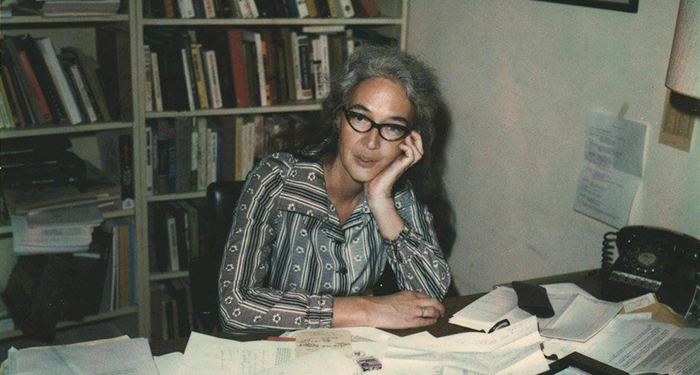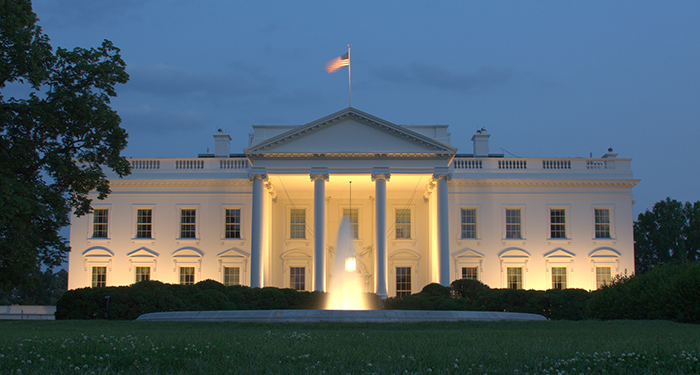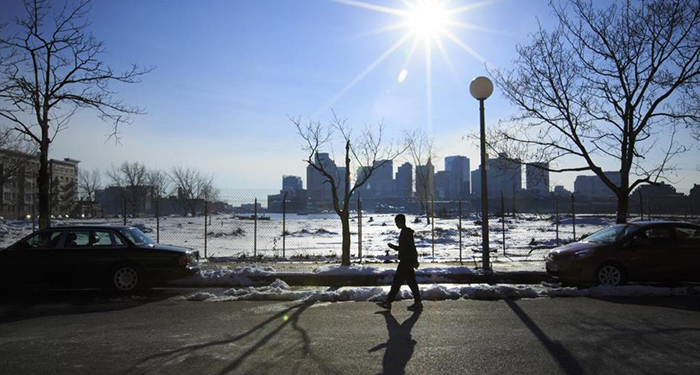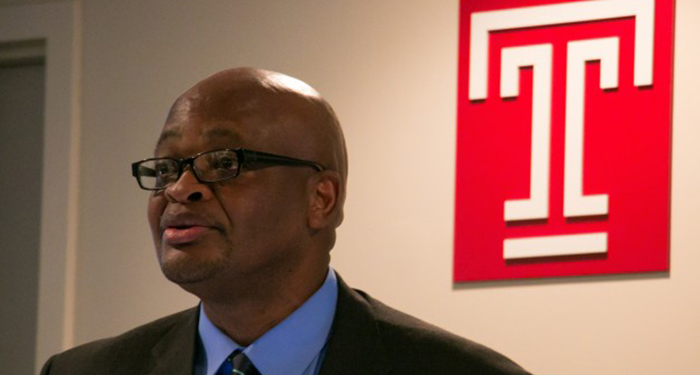Joan Moore and Latino Gang Research

This Friday, March 11, the Great Cities Institute will sponsor a forum on Latino gang research honoring Joan Moore. Several of her students, including Lalo Valdez and Diego Vigil, Robert Durán, Alice Cepada and John Hagedorn will present on their gang research and reflections on the influence of Joan Moore on their work.
Who is Joan Moore? Joan was the co-author of the country’s first large scale study on Mexican Americans. Her role in the Mexican American Study Project was to organize community studies across the Southwest to document the lives of what was called ‘the silent minority.” As Mexican Americans were protesting injustice in the late 1960s she worked with LUCHA, a self help group of ex addicts and pintos, or gang members founded in San Quentin prison. Together they embarked on an unprecedented study of male and female gang members in three East Los Angeles barrios and described generations of gang members and their changing struggles for justice and survival. The research questions of the studies were those the pintos themselves helped develop. Joan devised a never yet duplicated methodology in gang research of random sampling of rosters of gang klikas, or age-graded groups. The pinto researchers believed that good quality research and exposure of the discrimination and conditions of their lives could persuade policy makers and the public of the need for more humane public policies and the evils of a reliance on incarceration.
As is often the case in academia, no good deed remains unpunished and Joan was denied tenure at USC for blatantly political and non-scientific reasons. She moved to Milwaukee where I had the good fortune of learning from her collaborative methods which guided my studies of Milwaukee gangs. Joan retired twenty years ago and is bravely fighting terminal colon cancer.
Joan concludes her autobiography written for this forum in typically modest fashion. “I am enormously grateful to those who share my concerns with the vitality of collaborative research, with defensible methodology and with social justice. They help me feel that I’ve kept faith with our pinto collaborators.”
Joan Willard Moore is an exemplar of how to do research that can be useful for social justice and for Latino communities.
–
Grebler, L., Joan Moore, Ralph C. Guzman (1970). The Mexican-American People; The nation’s second largest minority. New York, The Free Press.
Moore, J. W. (1978). Homeboys: Gangs, Drugs, and Prison in the Barrios of Los Angeles. Philadelphia, Temple University Press.
Moore, J. W. (1991). Going Down to the Barrio: Homeboys and Homegirls in Change. Philadelphia, Temple University Press.
About the Author:
John Hagedorn, Professor of Criminology, Law and Justice. John Hagedorn is the author of People & Folks, Gangs, Crime, and the Underclass in a Rustbelt City. This book re-framed the study of gangs in the United States by focusing on the impact of deindustrialization. He is currently studying why Chicago’s homicide rate has not decline like New York City’s.
Loophole Planning and Infrastructure Making in Contemporary Mumbai
The URBANISM ACROSS PLACES, SPACES, DISCIPLINES working group
and the UIC Institute for the Humanities
present
Vyjayanthi Venturupalli Rao
Director of Terreform Center for Advanced Urban Research
March 3, 2016 at 3 PM
Institute for the Humanities, 701 South Morgan, Lower Level Stevenson Hall
“Loophole Planning and Infrastructure Making in Contemporary Mumbai”
As Mumbai prepares for its third DP, a fierce debate has broken out over the nature of development and of planning. Galvanized by civic activists, ordinary citizens are asking for specific information about land use reservations and plans for their own neighborhoods as well as raising questions that pertain to the city’s ecological health as a whole. In meetings organized by civic groups in the early months of 2014, concerned citizens asked questions about the relationship between the DP and issues as widely distributed as gender, healthcare, and digital access, along with other more familiar infrastructural issues. Remarkably, these meetings were hosted by the MCGM (Municipal Corporation of Greater Mumbai) itself, the body responsible for preparing the plan and finally led to a comprehensive revision of the plan.
In this talk I present an ethnography of the planning process and its implications for understanding an emergent relationship between land use planning and politics as it is unfolding in contemporary Mumbai. While earlier development plans had largely remained technocratic documents with little public participation, citizens now find themselves in a city in which thousands of square feet of new development has been added through various ad hoc, loophole measures. These measures completely bypassed the goals and vision of the previous development plans, mixing good intentions for increasing affordable housing and legal casuistry in strange cocktails and schizophrenic urban landscapes. Between 1991 and 2013 when the city’s development plan came up for its third iteration, such loophole planning ushered in a new definition of development, connecting the concept of development inextricably to rent-seeking from land development and construction. In the context of the rise of market-oriented governance, ‘informal’ methods of making social and material infrastructure are increasingly linked to varied forms and practices of speculation – not only the speculative development of fixed assets but also new forms of practice and usage, which assume the unpredictable, unexpected and nonlinear unfolding of existing systems that guide the experience of the city and of citizenship. This talk situates the relationship between planning, citizen-driven, iterative infrastructure making and new forms of political engagement in an age that demands a creative embrace of uncertainty.
Vyjayanthi V. Rao, Ph.D. is the Director of Terreform Center for Advanced Urban Research in New York. Prior to her appointment at Terreform, she taught anthropology and international affairs at The New School for Social Research and at The University of Chicago where she received her Ph.D. in anthropology. Other professional positions include Research Director of The Center for Cities and Globalization at Yale University and Co-Director of Partners for Urban Knowledge, Action and Research (PUKAR), an innovative urban laboratory in Mumbai, India.
She works on cities after globalization, specifically on the intersections of urban planning, design, art, violence, and speculation in the articulation of the contemporary global city. She is the author of numerous articles on these topics, which have appeared in Public Culture, New Literary History, Perspecta and Editoriale Lotus. Her edited volume,Speculation, Now: Essays and Artworks, produced in partnership with Carin Kuoni, Director of the Vera List Center for Art and Politics and graphic designer Prem Krishnamurthy was published by Duke University Press in 2015 and she is completing an ethnography of Mumbai’s spatial transformation titled “Speculative City: Infrastructure and Complexity in Global Mumbai.”
This lecture is free and open to the public.
Working group organizers:
Tarini Bedi, Anthropology
Sultan Tepe, Political Science
Rachel Weber, Urban Planning and Policy
Pipeline Politics: Oil, Borders and Energy Futures
The decision by President Obama in November 2015 to kill the Keystone XL pipeline project was followed a week later by new Prime Minister Trudeau’s implementation of a moratorium on oil tanker traffic on British Columbia’s coast, effectively killing the Northern Gateway pipeline project. The block on these two pipeline projects has left oil from the Alberta oil landlocked and with limited ways to get oil to markets. Does this mean that the environmental threat of large cross-country, cross-border pipeline projects is over? This paper will provide an overview of the politics of pipelines in North America. What does the present and future of pipelines in Canada and the US mean for the environments they traverse and criss-cross? Even if new projects are halted, what of the threat of more than 250,000 miles of large-diameter transmission lines (and far greater scale of gathering, feeder, and transmission pipelines) that are already in use in North American today?
Imre Szeman is Canada Research Chair in Cultural Studies and Professor of English, Film Studies and Sociology at the University of Alberta. He conducts research on and teaches in the areas of energy and environmental studies, literary and cultural theory, and social and political philosophy (esp. 19th and 20th left theory, globalization and nationalism), and Canadian studies. In 2015, Szeman received the J. Gordin Kaplan Award for Excellence in Research (2015), the U of Alberta’s most prestigious research award that recognizes research excellence in humanities, social sciences, law, education and fine arts.
Szeman’s on-going work in what he termed the “energy humanities” resulted in the founding of the Petrocultures Research Group in 2011 (www.petrocultures.com). Made up of more than 40 researchers, Petrocultures takes as its goal a deeper understanding of the cultural and social changes needed to enable a successful transition from fossil fuels to other forms of energy. This work with Petrocultures has resulted in several forthcoming publications, including: Imre Szeman, Jennifer Wenzel and Patricia Yaeger, eds., Fueling Culture: Energy, History, Politics. New York: Fordham University Press, forthcoming 2016; Sheena Wilson, Adam Carlson and Imre Szeman, eds. Petrocultures: Oil, Energy, Culture. Montreal-Kingston: McGill-Queen’s University Press, forthcoming 2016; (3) Imre Szeman. Globalization, Culture, Energy: Selected Essays, 2000-2013. Ed. Huimin Jin. Henan University Press, forthcoming 2016. (Translation of his into Chinese); and Dominic Boyer and Imre Szeman, eds. Energy Humanities: A Reader. Baltimore: Johns Hopkins University Press, in preparation. His is currently at work on a book entitled On Empty: The Cultural Politics of Oil, which will appear from Fordham University Press in 2017.
GCI Attends 2nd White House Convening on Participatory Budgeting

On Feb 22 and 23, 2016 Thea Crum, GCI’s Director of Neighborhoods Initiative, joined more than 60 community leaders, elected officials, researchers, and civic technologists in Washington DC, to map a future for Participatory Budgeting (PB) in the US.
The White House Office of Science and Technology Policy, Harvard’s Ash Center for Democratic Governance and Innovation, and the Democracy Fund hosted an event which built on an initial convening on PB in the US co-hosted in 2014 by The White House and The Participatory Budgeting Project (PBP).
It was just seven years ago that the first PB process in the US was launched in the 49th ward, Chicago. Since 2012 GCI has partnered with PBP, elected officials, community leaders and funders to expand PB to seven Chicago wards, one school and one tax increment financing district engaging over 9,000 Chicago residents in deciding how to spend more than $12 million in public dollars.
“Today there are over 46 processes, and The White House and Harvard are promoting PB as a best practice of local government. PB is repairing the relationship between government and the people,” said Josh Lerner, PBP Co-founder and Executive Director, at the event.

US Chief Technology Officer and Assistant to the President, Megan Smith shared The White House’s perspective that collaboration with and participation in government are the key to solving our nation’s greatest challenges. Ms. Smith stated that “Governments are just us. They’re whoever shows up.” She also shared the international commitments that The White House has made to supporting participatory budgeting efforts through the second and third US Open Government National Action Plans.
Attendees shared experiences, new data and tools for how to make PB and participatory governance more successful. Thea Crum served on the Advanced Participatory Budgeting panel and shared her experiences working with and evaluating PB processes in Chicago. “How we expand and institutionalize PB will depend on our goals. To reach our goals of equity and inclusion, we need to conduct PB processes with larger pots of money and with funds that can be used for programs and capital infrastructure so that we can truly address the most pressing needs in low-income communities of color” said Ms. Crum at the event.
Attendees left the event with clear commitments to expanding and supporting PB moving forward:
- Elected officials and community activists new to PB committed to building political support for PB in their communities and to attending the May Participatory Budgeting Conference in Boston to learn more about the PB process.
- Elected officials, PB practitioners, and researchers committed to sharing their experiences and expertise with new communities organizing to launch PB processes.
- Federal agencies already publicly supportive of PB will encourage other bureaus to officially embrace PB in national policies and plans.
Tom Glaisyer, Program Director for Democracy Fund, “proposed how PB could rapidly grow in scale: “$275 billion of the US federal budget is allocated to local governments each year, excluding health entitlement programs. That’s a huge opportunity for PB.”
Thank you to everyone who made this possible including the Administration’s commitment to supporting participatory budgeting and to the Chicago elected officials and funders, the PB Chicago City-Wide Steering Committee members, and residents who work every day towards building a more democratic Chicago.
In East Boston, pinched between progress and pain

Development of upscale housing in East Boston is affecting working-class people who have long populated the neighborhood. DINA RUDICK/GLOBE STAFF
The Boston Globe quotes John Hagedorn, UIC professor of criminology, law, and justice, in an article about the impact of gentrification in the East Boston neighborhood. Hagedorn discusses gang activity in changing urban neighborhoods.
John Hagedorn, a University of Illinois at Chicago professor and author whose recent book, “The Insane Chicago Way,” chronicled 1990 gang wars there, said young people can be left vulnerable and hopeless when they are displaced from their homes — and that’s when opportunistic street gangs can pounce.
“Gangs are all about the lack of hope in traditional mobility. If those avenues aren’t there, the gangs are going to get stronger,” Hagedorn said.
In Chicago, he said, Puerto Rican neighborhoods displaced by gentrification soon became hotbeds of gang activity.
With neighborhoods unsettled, Hagedorn said, kids were bouncing from school to school. Their futures were suddenly uncertain. The gangs grew in strength.
New York Times Calls for Congressional Action on Minority Joblessness

Keith Negley, New York Times
In its lead editorial, the Sunday New York Times, called for Congressional action to address conditions of unemployment in “minority” communities. Citing the Great Cities Institute report on joblessness among young people, the editorial goes on to express outrage that Congress has rejected programs that we know work and “that could help rescue a generation of young men from failure and oblivion.”
Specifically, the New York Times editorial references a component of the Recovery Act of 2009, an employment subsidy program that “created more than 260,000 temporary jobs.” The non-profit, Economic Mobility Corporation, released an analysis in 2013 through which they concluded that this program, which placed workers largely in the private sector, not only aided local businesses that did the hiring, but also those who were hired, increasingly their likelihood of finding permanent employment.
These promising results suggest that carefully targeted subsidies that place unemployed people into private-sector jobs can be a potent tool in reducing the devastating unemployment in minority areas of big cities where young people are disconnected from work and civic life.
As the Times points out, employment subsidy programs have been around since the 1930s. They suggest, however, that such programs should be created to place individuals in the private sector, including those who may have criminal records and need the opportunity to prove themselves as “motivated workers.” “Carefully developed subsidy programs are worth pursuing even if they do not produce big earnings gains. Getting jobless young people into the world of work is valuable in itself.”
The Times Editorial is a call to congressional action but concludes that if Congress fails to act, then this is something that the states should fund.
The idea of employment subsidy programs to place workers in the private sector, as already evidenced, can yield results. A subsidized employment program for public works, as we saw from the 1930s, could also put people to work, and at the same time, rebuild the decaying infrastructure in cities and states.
We are excited that the report from Great Cities Institute is generating conversation about solutions. This is a situation that calls for an array of strategies to address a set of conditions that did not occur overnight. The urgency of joblessness among young people, particularly among young Black men, calls for our focused and concerted attention to finding solutions.
Equitable TOD in Chicago

An equitable transit-oriented development (TOD) program is critical to the growth of metropolitan Chicago. Learn more about TOD tools and tactics developed by the Metropolitan Planning Council February 18 at a Spring 2016 Seminar Series event hosted by the Urban Transportation Center. The presentation will be led by MPC manager Yonah Freemark and is open to all. The event begins at noon and will be held in CUPPA Hall Room 110. Visit — utc.uic.edu/current-utc-
Winning Elections in the 21st Century
Tim Imeokparia Dissects the Possibility of a Different Economy in Ecuador

Dr. Imeokparia discussed Ecuador’s solidarity economy. Photo by JD Mousley.
Tim Imeokparia, director of research and planning for Great Cities Institute, spoke at Temple University solidarity economy of Ecuador and some of its theoretical benefits and shortcomings. The lecture was co-hosted by SMC, the Department of Geography and Urban Studies, the Global Studies Program, Academic Center for Research on Diversity, the Department of Agriculture, the Department of Architecture, the Department of Community and Regional Planning, and the Office of Institutional Diversity, Equity, Advocacy and Leadership.
“It [solidarity economy] is an economic practice that is non-economic,” Imeokparia said. Solidarity Economy is a push for a new economy, one focused on cooperation rather than competition. It is a system that is based on mutual assistance.
During his presentation, Imeokparia spoke about the theoretical benefits of the solidarity economy to Ecuador. He emphasized the ambition to transform Ecuador to an industrial or service economy. The idea of solidarity economy was written into Ecuador’s constitution in 2008. Since then, the government invested in roads, education, Internet access and more.
One such initiative is building a “City of Knowledge” in Yachay, Ecuador, complete with a university that will attract students and scientists.
But, Imeokparia noted, this vision is far from perfect—the strategy of solidarity economy falls short of expectations. “It becomes something ideological, it doesn’t transform the production matrix,” Imeokparia said. One reason for this issue, he said, is because the state is pressing for modernization, but the market isn’t ready for it.
Full Story from Temple University School of Media and Communication »